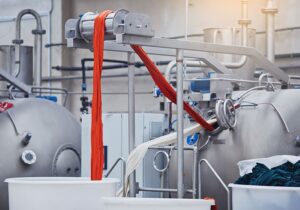Polyester vs. Cotton: Is the Polyester REALLY More Sustainable Fabric?

Table of Contents
ToggleThe selection of sustainable fabric is more important these days to decrease the damage to environment. The fashion industry is under increasing scrutiny for its environmental impact. Two of the most commonly used fabrics, polyester and cotton, often find themselves in the sustainability spotlight.
Sustainable Fabric: The Polyester Perspective
Polyester, a synthetic fiber derived from petroleum, has long been positioned as a more sustainable fabric option than cotton. Its proponents often cite these points:
Durability
Polyester is generally more durable than cotton, meaning it might last longer, reducing the need for replacements.
Water Usage
Polyester production requires significantly less water compared to cotton cultivation.
Quick Drying
Polyester dries faster, reducing energy consumption for drying.
Sustainable Fabric: The Cotton Counterargument
While polyester has its advantages, cotton, a natural fiber, shouldn’t be dismissed outright.
Renewable Resource
Cotton is a renewable resource, capable of re-growing after harvest.
Biodegradability
Cotton is biodegradable, unlike polyester which contributes to micro-plastic pollution.
Versatility
Cotton is incredibly versatile, suitable for a wide range of products beyond clothing.
A Deeper Dive: The Environmental Impact
To truly assess the sustainability of polyester and cotton, we must examine their entire lifecycle, from production to disposal.
Production
Polyester
Requires fossil fuels, a non-renewable resource. Production releases harmful chemicals and greenhouse gases.
Cotton
Intensive water usage, especially in regions facing water scarcity. Pesticide and fertilizer use can contaminate water bodies.
Usage
Polyester
Durable but prone to shedding micro-plastics, contributing to pollution.
Cotton
Requires frequent washing, which can lead to higher water and energy consumption.
Disposal
Polyester
Non-biodegradable, contributing to landfill waste and micro-plastic pollution. Recycling options are limited.
Cotton
Biodegradable but often treated with chemicals, affecting its decomposition rate.
Comparison Table
Feature | Polyester | Cotton |
Production | High energy, low water | High water, potential chemical use |
Biodegradability | Non-biodegradable | Biodegradable |
Durability | High | Moderate |
Water Usage | Low | High |
Micro Plastics | High | Low |
The Verdict about Sustainable Fabric: It’s Complicated
Both polyester and cotton have significant environmental drawbacks. The “more sustainable fabric ” choice is not straightforward.
To make more informed decisions, consider the following:
Choose recycled polyester to adopt more Sustainable Fabric
This reduces reliance on virgin polyester.
Opt for organic cotton
Grown without harmful chemicals, it reduces environmental impact.
Extend garment life
Proper care and repair can extend the lifespan of both polyester and cotton items.
The Importance of Supporting Sustainable Fabric Brands
Choose brands committed to ethical and environmentally friendly practices that consistently use sustainable fabrics in their products. Ultimately, the most sustainable fabric choice is often a blend of both fibers, tailored to the specific product and its intended use. Remember, no single material is perfect; a holistic approach that considers the entire lifecycle of a product is crucial for making more sustainable fashion choices.
Arbish Sports: A Commitment to Sustainability
Arbish Sports, a garment manufacturing company from Sialkot, Pakistan, has been dedicated to sustainable practices since 2006. The company implements the practice of always using sustainable fabrics in its products, ensuring that athletes and consumers can make responsible choices while enjoying high-quality sportswear.
- Facebook
- Twitter
- Linkedin
- Whatsapp





